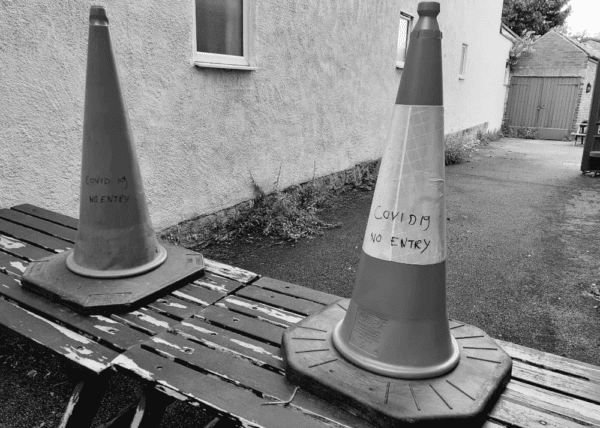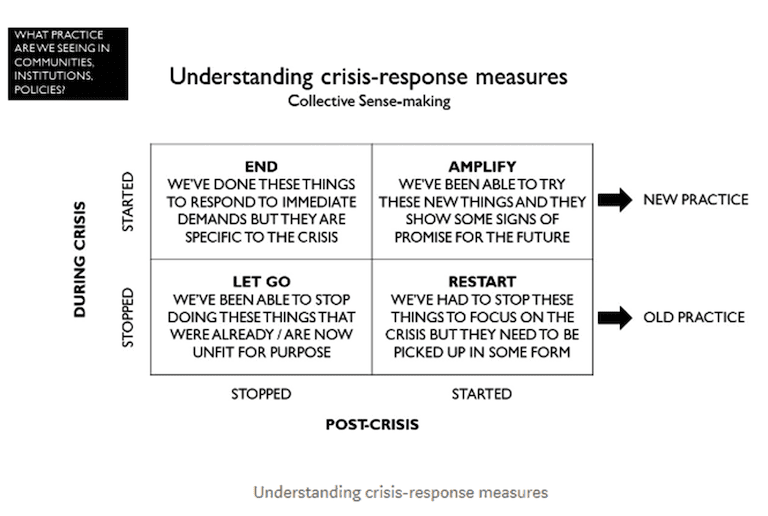How To Provide Leadership Through Crisis…
I imagine there are thousands of journal articles, academic papers and written thoughts concerning the current pandemic of Covid-19. There will be many more in the coming months and years as we try to make sense of it all. Differing aspects will be presented from well being to managing teams through to leadership models. In reality, the one element we need to keep in mind is our agility to change and consider the present. Certain leadership models will just not work when faced with this kind of scenario. Aspects of a number of leadership models fail to consider the necessary requirement when a national instruction has been issued. Effectively crisis leadership demands holistic clarity and resilience that may not have emerged in the same way previously.
One thing to bear in mind when considering emergent models will be the quality of research and appropriation to our lives at that time. If not, we potentially fall back into the world of ‘experts’ where well-meaning individuals provide their knowledge as truth. With this in mind, this piece considers crisis leadership developed during the current situation with outcomes and, unusually, the past in mind. Moreover, there is an honest attempt to consider how we can lead and provide direction in the here and now.
All Stop
Covid-19 prompted a response from the government that has not been experienced before. This national instruction and the change it brought will have affected each individual in differing ways. For many, this would have invoked a ‘what do I do now?’ response, leading to an all stop situation.

For most, this was an ‘I don’t know what to do’, rather than a ‘won’t do’. We were, and probably still are, not ready for such a dramatic change to our personal situations. The all stop approach is a natural reaction in any change. Questions such as, ‘what does this mean for me?’ often occur. This can invoke differing reactions in people such as anxiety, shock, and clarity for some and anything in between. It is at this point we look to our leaders for information, direction and a sense of purpose. Often, we fail to consider the impact on leaders due to the view of our own situation.
Stop, Pause And Reflect
A recent Health Service Journal article indicated that NHS managers are working more than 20 hours over their contracted hours. If this is week-in-week-out, fatigue will set in, performance drops, and mistakes are made. In essence, the more hours worked, the lower the actual performance leading to possible sickness. There has been, in some articles, recognition to stop, pause and reflect and understand the silence after the noise.
This has been a prevalent message from many sectors, and not least for healthcare. As this pandemic is a new scenario for every individual, team and organisation, this would seem like sage advice. A question here would be, to reflect on, what? Try as we might, there is little to go on in terms of active models and guidance to work through. Though collective sense-making, stopping, pausing and thinking can at least provide a point of reference.
Leading With Resilience
Leaders and managers will be measured partly for their follow through on what they say. For the main part, this will require resilience through a nationally imposed change. One psychological definition of resilience is:
‘The process by which individuals demonstrate more positive outcomes than would be expected’.
Personal resilience can only be understood in the context of responding to significant adversity. Recent research for the University of Oxford provides a view of resilience. It states individuals who see a crisis as an opportunity to grow and learn, tend to be more resilient. In this mindset, a positive view of outcomes is adopted to guard against negative effects promoting positive mental health. Within this, selective attention, not being pulled into a negative mindset, and effective processing sets the agenda for a strong foundation. This foundation is the groundwork for motivational change and adaptive behaviours where adversity is a threat.
There is no doubt that Covid-19 has created a situation that is life-changing. Some people are thriving, some are barely surviving and, sadly, recent statistics show that some are not surviving. These are the deeper scars this situation has left us with. It is these kinds of experiences that make viewpoints such as ‘let’s just get on with it’ absolute nonsense. The push back here is ‘get on with what’? The issue with personal resilience is that this is not an all or nothing trait. It is probably the case that some individuals are more resilient than others in given circumstances. This is especially the case where there is a focused positive cognitive pattern than not.
Affecting Change in A Crisis
Through pausing, we can begin to look to gain some kind of clarity on our situation. While we read in the news all the political decisions being made, there is a need to focus on ourselves. Affecting change in a crisis could ask us to consider change modes such as the Kubler-Ross model. This is a useful starting point for behaviours and emotions but does not help in terms of organisational crisis leadership.

We need to turn thought into action, what we need to do. Therefore, a starting point for pausing should note that we can’t affect external changes. A focus on what we can affect seems a logical and helpful place to begin. Left unchecked, we could continue to perform work that is not relevant for this time. While action is applauded are we affecting the right things?
One element to consider here is the curse of inaction. Inaction occurs when we don’t know what to do and therefore do nothing at all.
There is a saying:
‘You can’t plough a field by just thinking about it’
So, through pausing for a moment we can collect our thoughts, think about our businesses and teams and plan the action.
Attributes Over Skill
Attributes are our innate qualities such as patience, adaptability and situational awareness. These come into play when we enter unknown situations and are uncertain of the events. Attributes come forward through our behaviour in these crisis situations and show us and others that essence of leadership.
Attributes win out over skill because skill is gained through many hours of practice, riding a bike, driving a car and such. Let’s consider athletes, they become the top of their game through repetition and constant practice. There is a natural end game here. When a crisis happens, that skill is rendered almost useless. Patience, adaptability and situational awareness will provide better outcomes than relying on skills alone. Trying to push your skills into this situation will only serve to make you weary and question yourself.
Situational awareness linked with pausing and allowing time to reflect will provide clarity. A series of questions can be answered in this moment:
- Is the ‘ask’ right now?
- What would make the most difference to our team now?
- Is this our highest priority?
- When have we faced similar challenges? What helped?
- What skills and experiences do we have to overcome this? Who else can help?
- What actions will we take?
- What routines or processes do we need to set up?
The list could go on. These are a good starting point for reflection, utilising situational awareness and enhancing attributes over skill. Linked to the collective sense-making model below, a clearer way forward begins to emerge.
Collective Sense-Making for Crisis Leadership
The collective sense-making model offers us an opportunity not only to pause but add meaning and clarity. When the crisis of Covid-19 broke, many of those still working will have tried to organise their previous normal. This would have been an attempt to ‘hold on’ to some kind of normality. It rarely makes sense for us to stop or drop what we are doing except in a crisis. The ability to think clearly and rationally is superseded by panic and shock.
Consider the model below (Image credit: RSA (2020)-Ian Burbidge):

This model provides us with a plan to move forward with clarity. While a reflective model, it asks us to understand the present and future and not the past. This is a pertinent point as the current crisis did not exist before February 2020. Therefore, your processes may have been right for that time. There is a need for honesty within this model mainly considered when we review the ‘Let Go’ quadrant. When observed in action, the crisis-response model has the ability to aid in understanding efficiencies.
Old Practice / New Practice
If we break the model down to old practice / new practice we can reflect on what we require moving forward. This considers your operating model and what you might like to bring forward into the new world. ‘Let Go’ offers an opportunity to drop the processes that are not fit for purpose moving forward. This may be the largest change and the area where you may need to convince others. This will also mean a more directive leadership style during the crisis. The reason is there may be a comfort for employees in performing processes the old way. ‘Restart’ is not exactly doing what we always did. They are, however, processes that are generally critical but may not need to be performed in the same way. This is a change in itself.
End / Amplify
The End/Amplify quadrants are potentially the most challenging. End is a response to the crisis itself and has been useful in carrying through decisions based on the situation. Individuals and teams may view this as their ‘new normal’ and wish to continue. This view is taken because it works and results are provided. There needs to be a realisation that this process will only work for now. This is where the challenge of ‘Amplify’ comes into play. Amplify is maximising the opportunity that the crisis brought.

This may seem callous and insensitive. Covid-19 has brought benefits that would have taken years to realise. A pragmatic approach to Amplify does need to be taken. This is about potential not an absolute. This is about using this time to test, evaluate and select the right elements to pursue. More than this, consider the agility and emerging themes from these.
While the collective sense-making model is not a replacement for a strategy. It is a temporary state that can move us to action while concentrating on the right actions. It may provide the opportunity for a strategy refresh, especially where ‘amplify’ processes are working. The collective sense-making model concerns change and change usually concerns people. This is their journey also. Through anecdotal evidence, some individuals have thrived through this situation. Realising their talent and agility is essential. The ‘collective’ element in this model is as important as the matrix itself. Allow others to be a major part of the change and seek their input.
Final Thoughts
Whichever business you are in, Covid-19 is a crisis that will have changed the way you operate and approach leadership. At least, for the time it is here. From moving our organisations online to the way we physically connect with each other. Collective sense-making provides an opportunity to pause for a moment and provide a certain direction. As stated in the introduction, there will be a huge amount of research in the coming years.
This article looks to provide some essence of clarity now in a very confusing time. While our teams get to grips with their new situations, there is a chance for leaders to pause. An opportunity to prioritise and understand what is essential to moving from surviving to thriving.
Action: For even more useful content on leadership, check out our ultimate guide on Leadership Skills.




